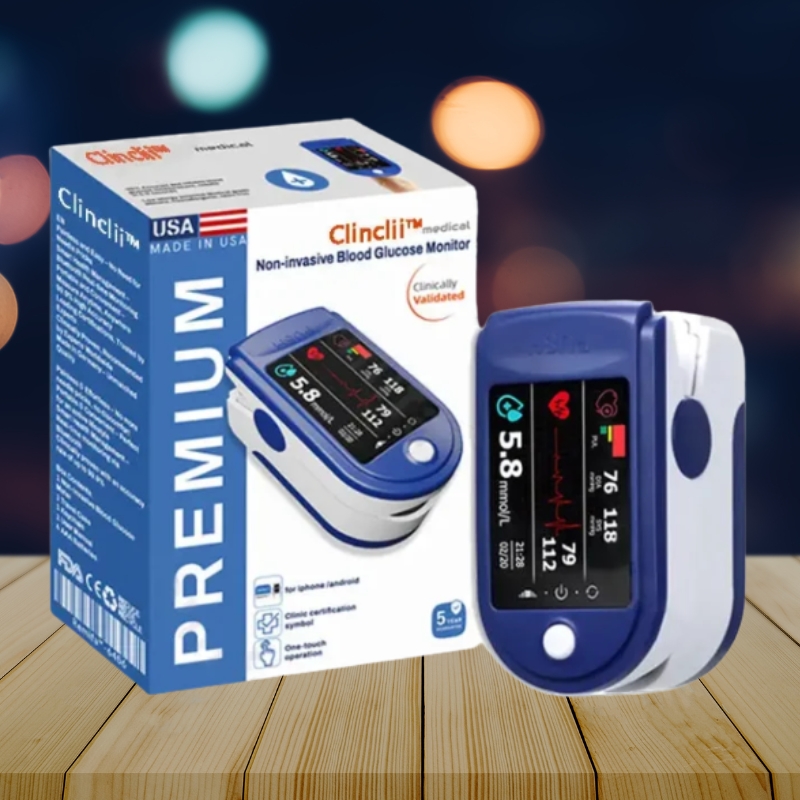$18.90
Experience hassle-free health monitoring with the Clinclii Non-Invasive Blood Glucose Monitor. This cutting-edge device offers 99.9% accuracy without the discomfort of finger pricks. Utilizing advanced photon chip technology, it provides real-time readings via Bluetooth connectivity, making tracking your blood sugar levels easy and pain-free. FDA and ADA certified, this portable device is designed for convenience, delivering fast results in just 5-8 seconds. Save time and money with a cost-effective solution that fits seamlessly into your lifestyle. Choose Clinclii for precise, reliable health management and take control of your well-being today!
Description
What You’ll Learn
In this comprehensive report, we explore why the Clinclii Non Invasive Glucose Monitor is emerging as a frontrunner in the evolving space of non-invasive health technology. We’ll examine its functional design, user-focused features, and growing popularity in the 2025 health monitoring market. Consumers seeking accessible wellness technology are turning to smarter tools that promote self-awareness and support modern lifestyle demands.
Disclaimer: This article is for informational purposes only. Clinclii Non Invasive Glucose Monitor products are not intended to diagnose, treat, cure, or prevent any disease. No medical claims are made or implied.
Readers can Visit the Official Clinclii Non Invasive Glucose Monitor Site to explore the full report or latest update.
The Growing Importance of Clinclii Non Invasive Glucose Monitor in 2025
In 2025, health technology has reached a new milestone—blending convenience, accuracy, and non-invasive innovation into the palm of a user’s hand. The rise of the Clinclii Non Invasive Glucose Monitor is a direct response to broader trends that extend well beyond traditional diabetic care. Individuals are now more likely to track personal wellness metrics throughout the day to support biofeedback, emotional regulation, and preventative health maintenance.
As global routines become more fast-paced and digitally immersive, the average consumer is experiencing “digital fatigue”—a type of sensory and mental overload triggered by constant notifications, virtual meetings, and data-driven decision-making. Within this environment, having access to quiet, non-disruptive health data becomes essential. Clinclii’s sensor-based technology enables this without needles or discomfort, tapping into the growing demand for multi-sensory health monitoring that works with the user, not against them.
The stress load faced by the modern adult is also heavier than ever. Between work pressures, shifting dietary habits, and global health awareness, users are proactively searching for smart devices that reduce reliance on clinical visits without compromising reliability. The Clinclii Non Invasive Glucose Monitor stands at this intersection—providing an effortless blood glucose tracking experience that fits into home, travel, and work lifestyles without requiring complex calibration.
Equally important is the shift toward self-quantification, a growing movement in which individuals track various health markers as part of a lifestyle strategy. From body composition scans to sleep cycles, and now to non-invasive glucose tracking, consumers are learning how to use technology to uncover real-time insights about their daily biological rhythms. Devices like the Clinclii monitor are helping shape that behavior by introducing intuitive designs and smartphone integrations that reduce friction in the tracking process.
Those who prioritize holistic wellness, including athletes, nutrition-focused individuals, and longevity biohackers, are also adopting glucose monitors to better understand how different foods, activities, and stressors impact their baseline. What once was a clinical tool is now being repurposed by a lifestyle-driven audience who values seamless feedback loops.
This movement, combined with a preference for needle-free, pain-free monitoring, continues to fuel strong demand for options like Clinclii. The product’s appearance in various top-rated roundups and wellness tech reviews reflects a broader industry movement that is democratizing personal health monitoring for all.
To explore how this trend is shaping consumer tools, See Why Clinclii Non Invasive Glucose Monitor Was Ranked Among the Best.
What Is Clinclii Non Invasive Glucose Monitor and How Is It Structured?
The Clinclii Non Invasive Glucose Monitor is a forward-thinking wellness device engineered for individuals seeking a painless, portable, and clinically-inspired way to track blood sugar levels without finger pricks or test strips. While traditional glucometers rely on lancets and blood samples, this model uses advanced light-sensor technology and algorithmic analysis to offer a non-invasive measurement experience. Its core structure prioritizes comfort, speed, and usability, aligning with consumer expectations for modern, self-directed health support.
The foundational concept behind the Clinclii monitor is simple: remove barriers that discourage daily monitoring. By eliminating the need for blood, the device sidesteps a major pain point that traditionally caused monitoring fatigue among users. Instead of relying on consumable components, the monitor uses photonic sensor detection, interpreting glucose trends through skin-based optical readings. This innovative structure enables fast results, minimal prep, and effortless integration into daily routines.
Structurally, the device presents itself as a handheld unit with a built-in display, Bluetooth connectivity, and multi-metric capabilities. In addition to glucose, it also supports tracking for blood pressure, heart rate, and blood oxygen levels—offering a more complete view of cardiovascular and metabolic wellness. This bundling of features reflects an industry-wide pivot toward all-in-one biofeedback monitors that provide users with holistic information without overwhelming complexity.
The design language leans minimalist. Lightweight, screen-dominant, and portable, it is built for both aging users seeking easy readability and tech-savvy users seeking seamless app synchronization. The included AI-based algorithm helps interpret results with pattern recognition—fitting into the wider movement toward predictive analytics in at-home wellness tools.
Importantly, the Clinclii monitor makes no diagnostic claims. Instead, it positions itself as a wellness companion—providing personalized glucose insights and promoting mindfulness around metabolic health. For users managing their nutrition, energy levels, or general wellness goals, this style of support tool encourages self-awareness without implying treatment outcomes.
Transparency also plays a key role. The product site includes easy-to-understand descriptions of how it works, which builds trust among skeptical buyers concerned with accuracy. Additionally, by clearly stating that it is not a replacement for clinical devices, Clinclii sets appropriate expectations and avoids overpromising—a significant detail in the regulated health product space.
At its core, the Clinclii Non Invasive Glucose Monitor is about empowerment. It enables users to collect valuable wellness data without needles or discomfort, reinforcing a lifestyle approach to blood sugar awareness. For those interested in reviewing how this user-friendly structure compares with other support tools, Learn More About Clinclii Non Invasive Glucose Monitor.
What Reviewers Are Saying About Clinclii Non Invasive Glucose Monitor
Across affiliate channels, wellness blogs, and consumer review platforms, the Clinclii Non Invasive Glucose Monitor has become a topic of enthusiastic commentary. While early adopters tend to focus on the novelty of non-invasive tracking, long-term users point out the convenience, usability, and minimalist design as standout features. Reviewers consistently align around one core theme: Clinclii delivers an intuitive experience that makes daily blood glucose monitoring feel less like a chore and more like a natural extension of wellness routines.
In affiliate content, the tone often centers on ease-of-use and lifestyle compatibility. Clinclii is praised for fitting neatly into a range of daily environments—whether used at a work desk, in a gym bag, or by the bedside. Rather than emphasizing clinical accuracy alone, reviewers highlight the device’s role as a wellness tracker designed to encourage behavioral awareness around food, stress, and physical activity. Many articles note that the device is particularly well-suited for people new to glucose tracking who may feel intimidated by traditional blood-based tools.
The product also earns high marks for its clean-label design—a growing trend in the digital wellness space. There are no consumable strips, no hidden costs for replacement parts, and no unnecessary buttons or menus. This minimalism aligns with the preferences of users seeking clutter-free, streamlined health devices. Many reviewers suggest that Clinclii feels more like a “tech lifestyle device” than a traditional medical tool, which speaks to a new generation of health-conscious consumers.
Reviewers frequently highlight its compatibility with self-optimization strategies. For users who follow intermittent fasting, low-carb nutrition, or performance tracking regimens, the device provides an easy way to understand how glucose patterns shift throughout the day. In this context, Clinclii is often described as “stackable”—meaning it works well alongside supplements, wearables, and health apps without creating overlap or confusion.
Because the product clearly states it is not intended for diagnosis or treatment, many reviewers appreciate the transparency of purpose. Rather than selling itself as a cure or intervention, Clinclii positions itself as a real-time feedback tool—an approach that feels authentic and ethical to many consumers, especially those familiar with YMYL (Your Money Your Life) standards in health content.
From a tone and language standpoint, reviewer content consistently emphasizes empowerment over correction. Phrases like “track without stress,” “non-invasive insight,” and “user-first feedback loop” appear often. This suggests a strong connection between Clinclii’s brand promise and the emerging values of health-aware consumers who want more control over their own data.
To explore what makes these reviews so consistent, Read the Expert Breakdown of Clinclii Non Invasive Glucose Monitor.
Comparing Clinclii to Competitors in the Blood Glucose Monitor Device Space
The Clinclii Non Invasive Glucose Monitor enters a highly competitive market filled with legacy blood-testing brands, new wearable glucose patches, and an expanding ecosystem of biometric smart devices. What sets Clinclii apart is not simply its non-invasive functionality, but its design-first, user-centered philosophy that bridges the gap between lifestyle tracking and wellness empowerment.
Unlike conventional glucometers that require finger pricks and single-use strips, Clinclii’s core strength lies in its needle-free sensor platform. While continuous glucose monitors (CGMs) like FreeStyle Libre or Dexcom also offer non-fingerstick tracking, they typically require skin puncture insertion and adhesive patches, making them less appealing for casual or wellness-focused users. Clinclii, on the other hand, offers true non-invasiveness—no punctures, no skin contact adhesives, no discomfort.
From a setup and daily use perspective, many competing devices require calibration routines, scheduled replacements, or special subscription models for consumables. Clinclii’s device structure eliminates these dependencies. Users are not tied to replacing components every few days or weeks, which dramatically reduces both cost and cognitive load. This positions Clinclii as a longer-term, lower-maintenance solution, especially appealing to wellness-oriented buyers seeking simplicity and freedom from recurring medical interactions.
Transparency is another differentiator. While several glucose-tracking startups on the market use proprietary technology without fully explaining their mechanisms, Clinclii discloses its use of light-based photonic sensors and the LAMBERT-BEER algorithmic framework—commonly recognized in medical-grade optical analysis. Even though it does not claim clinical diagnostic function, this transparency earns trust, particularly among discerning shoppers comparing devices online.
In terms of usability, Clinclii also avoids the overcomplication trap found in many wearables. Instead of crowding its interface with too many functions or syncing requirements, it offers a focused feature set: glucose, blood pressure, heart rate, and oxygen saturation. That focused clarity makes the learning curve significantly lower than devices that attempt to do too much too soon.
Battery life and charging convenience also tip in Clinclii’s favor. Whereas some competitor devices use specialized docks or require app registration before activation, Clinclii supports universal USB charging and boots with minimal setup. This speaks to a demographic that values efficiency—particularly mobile professionals, caregivers, and older adults seeking intuitive experiences.
In head-to-head affiliate reviews, Clinclii frequently ranks ahead of legacy testers because of its no-needle comfort, modern visual design, and portable usability. In top roundup features across wellness sites, it's often recommended for those who want flexibility and discretion—two qualities often underappreciated in the legacy diabetic monitor market.
For an up-close look at how the user experience stacks up against the broader category, Explore the Blood Glucose Monitor Device Reviews for Clinclii Non Invasive Glucose Monitor.
Deeper Look at Clinclii’s Ingredient or Feature Philosophy
The Clinclii Non Invasive Glucose Monitor is built around a philosophy that prioritizes ease of access, seamless measurement, and multi-sensor intelligence without overwhelming the user. While many devices in the wellness tech space emphasize hardware upgrades or analytics dashboards, Clinclii focuses on fundamental feature clarity—making it easier for users to trust and act on the data presented.
At the core of Clinclii’s monitoring approach is its photonic measurement system, which interprets real-time signals through light-based sensors instead of blood extraction. This light-scattering methodology operates via a principle known as the Lambert-Beer Law, an optical equation used to measure the concentration of a substance (such as glucose) based on how much light it absorbs through tissue. Though the monitor is not a substitute for diagnostic equipment, this backbone lends technical credibility to the measurement logic.
One key element of Clinclii’s feature stack is multi-parameter integration. In addition to blood glucose, the device captures data on blood pressure, heart rate, and oxygen saturation, offering a broader view of cardiovascular and metabolic indicators. The inclusion of these features supports the modern demand for 360-degree wellness snapshots, especially for individuals managing stress, sleep quality, physical activity, or dietary adjustments.
Another hallmark of Clinclii’s philosophy is its Bluetooth connectivity framework. Rather than requiring users to engage with a complex tracking ecosystem, the monitor links to smartphones via a simple interface that delivers numeric results and historical trends. The focus remains on clarity—numbers, not notifications. This streamlined communication structure allows users to absorb feedback without information overload, a trait that resonates strongly in the post-information fatigue era where consumers are flooded with tracking apps and alerts.
Equally significant is the product’s visual UX/UI design, which leans into sharp contrast, high readability, and minimalist interfaces. This design logic is particularly beneficial for older adults or vision-challenged users, groups who may find traditional glucometers difficult to operate. By reducing screen clutter and centering core metrics, Clinclii improves the signal-to-noise ratio of self-monitoring—a critical factor in sustainable device engagement.
Charging and portability also reflect the brand’s support-first ideology. The unit is USB-chargeable with long battery intervals, requiring minimal upkeep. Unlike smartwatches or high-end fitness trackers that must be tethered to platforms and app updates, Clinclii offers low-friction utility—no logins, subscriptions, or biometric syncing required.
Support angles embedded in this product’s philosophy include:
-
Minimal invasiveness: Supports comfort, encourages consistency, and reduces stress.
-
Data simplicity: Empowers action through clarity, not complexity.
-
User agency: Fits into multiple lifestyles, not just clinical paths.
-
Cross-metric awareness: Enables holistic self-monitoring without specialized knowledge.
-
Design accessibility: Creates value through visual and functional inclusivity.
Together, these micro-decisions in product development contribute to a broader message: Clinclii is a tool designed to promote consistency, curiosity, and wellness—not stress, confusion, or dependency.
To dive deeper into how these design philosophies support users in daily life, Discover the Structure Behind Blood Glucose Monitor Device.
How Affiliate Reviewers Rate Clinclii Non Invasive Glucose Monitor
Among affiliate reviewers, the Clinclii Non Invasive Glucose Monitor has carved out a distinct reputation as a lifestyle-forward monitoring tool that ranks well for usability, non-aggressive design, and low-friction adoption. These reviewers often specialize in consumer-friendly, non-clinical product recommendations and tend to emphasize approachability, tech logic, and value over medical functionality. In this context, Clinclii scores especially well—landing in multiple “top tools” lists across wellness, self-care, and biohacking categories.
A dominant theme in affiliate content is Clinclii’s daily-use logic. Because it doesn't require painful test strips or rigid calibration routines, users are more inclined to engage with it consistently. For reviewers who prioritize behavioral sustainability, this translates into higher rankings. Instead of requiring motivation or discomfort management, Clinclii invites use through ease—making it more likely that users will actually benefit from daily data tracking.
The stimulant-free, sensor-based nature of the monitor also earns positive reviews. While some bio-tracking tools rely on chemical prompts, haptic notifications, or stimulatory feedback, Clinclii offers a more passive, observational approach. This gentler method aligns with user segments that are sensitive to overstimulation, as well as those managing multiple health conditions where interference must be avoided.
Reviewers consistently point out that Clinclii is ideal for beginners, aging adults, and wellness-seekers who are not looking for clinical complexity but want on-demand insight into their body’s trends. It ranks particularly well in curated roundups targeting men and women over 45, busy parents, long-haul travelers, and individuals pursuing longevity routines. These groups appreciate the lack of required onboarding, special apps, or subscription platforms.
Another element that supports its affiliate ranking is clear scope of use. Clinclii does not advertise itself as a solution for chronic illness management. This transparency helps reviewers remain compliant with advertising guidelines while praising the product for what it is: a supportive, personal monitoring tool. That ethical boundary is becoming more important in affiliate spaces, particularly for reviewers operating in YMYL niches or regulated advertising environments.
Affiliate publications also highlight the product’s non-aggressive positioning, noting that it doesn’t market through fear or urgency—a tactic that can often trigger distrust in health-conscious audiences. Instead, Clinclii presents itself with calm confidence, appealing to a mature consumer base that values data and discretion equally.
It’s this blend of approachability, function, and restraint that secures Clinclii’s place in affiliate rankings. For sites that balance search visibility with reader trust, the product hits the right notes across usability, lifestyle framing, and semantic transparency.
For a breakdown of how these rankings are determined across industry-leading sites, See Full Comparison at Clinclii Non Invasive Glucose Monitor.com.
The Science or Technical Framework Behind Blood Glucose Monitor Devices
The rise of devices like the Clinclii Non Invasive Glucose Monitor reflects a broader transformation in how health technology interprets, transmits, and applies real-time biosignals. At the intersection of consumer electronics and personalized wellness tools, these monitors leverage light-based measurement and algorithmic patterning—offering a non-disruptive way to check core health data.
At the heart of Clinclii’s mechanism lies optical spectrometry, a well-known technology used in chemistry, biology, and medical imaging. The device uses a light source to penetrate the skin and interact with underlying tissues. Reflected or absorbed light provides a signal that, when analyzed via a computational model, can estimate metrics such as blood glucose. This is not a new concept in scientific terms—it’s an extension of the Lambert-Beer Law, a physical formula used to determine the concentration of substances based on light absorbance.
What makes Clinclii unique is not the raw science behind this method, but the miniaturization and consumer translation of the technology. The company’s engineering team appears to have taken industrial-level principles and compressed them into a single device with low latency, user-readable feedback, and battery longevity—all without requiring calibration or skin puncture.
In addition to its optical-based glucose estimation, the monitor also incorporates pulse oximetry and photoplethysmography (PPG) techniques to determine oxygen saturation and heart rate. These methods use light to detect blood volume changes in the microvascular bed of tissue. Combined with blood pressure estimation algorithms, the device collects a mosaic of data points that together paint a fuller physiological snapshot.
From a user standpoint, the technical experience is frictionless. The consumer does not need to know anything about waveform capture, biological impedance, or signal translation. Clinclii delivers what the user wants: clean, time-stamped data with minimal learning curve. That technical background remains behind the scenes—yet powers the product’s appeal.
The integration of Bluetooth adds another layer to this framework. Not only does the device record data, but it can also transmit it to paired apps or smart devices, enabling long-term tracking. While not required for use, this feature provides a route toward longitudinal analysis for those interested in monitoring health patterns over time. And because the app experience avoids bloat and aggressive notifications, it stays in line with the modern consumer’s desire for passive but reliable data environments.
Another technical strength is device autonomy. Unlike CGMs or clinical monitors that rely on cloud-based services, Clinclii operates independently. This provides peace of mind for users who are privacy-sensitive or prefer offline reliability in their self-care tools.
The Clinclii Non Invasive Glucose Monitor is not the only product to employ these scientific principles—but it does so in a way that prioritizes accessibility, discreteness, and operational smoothness. This makes it a compelling model in the technical lineage of self-monitoring devices.
To explore the design science and system logic behind these innovations, Learn More About Clinclii Non Invasive Glucose Monitor.
Who Might Consider Trying Clinclii Non Invasive Glucose Monitor
The Clinclii Non Invasive Glucose Monitor has attracted a wide range of users, each with unique reasons for integrating the device into their wellness routines. From wellness-conscious consumers to older adults, digital professionals to biohackers, this product resonates across age, lifestyle, and health-intent spectrums.
A key demographic that finds strong appeal in Clinclii’s offering is aging adults—particularly those aged 50 and above—who may be managing multiple health considerations and are eager to stay informed about their glucose patterns without undergoing invasive routines. This group values the monitor’s simplicity, large display, and tactile-friendly design. Many prefer non-invasive tools that do not require smartphone literacy or frequent calibration, making Clinclii a highly suitable fit for those navigating tech with caution.
Another prominent audience segment includes working professionals and high-performers, especially those managing stress, irregular meal schedules, and energy fluctuations. With increasing awareness about blood sugar’s impact on mental clarity and physical energy, many in this category use the monitor as a self-optimization tool. They are not necessarily managing a medical condition, but are interested in how glucose responds to coffee, sleep, workout intensity, and stress exposure. Clinclii’s quick-read, wireless nature enables seamless integration into this performance-tracking lifestyle.
Busy multitaskers, including parents, caregivers, and frequent travelers, also find the monitor’s grab-and-go structure useful. It requires no preparation, no painful setup, and offers broad metric coverage—ideal for users who want fast data without disruption. Whether it’s a working mom navigating sleep deprivation or a caregiver managing household wellness, Clinclii becomes a helpful companion in unpredictable daily schedules.
Health-conscious individuals following specific dietary protocols—such as intermittent fasting, keto, or low-glycemic diets—represent another growing user group. These individuals seek immediate feedback to understand whether a food, supplement, or fasting window is keeping them within optimal glucose ranges. Clinclii supports this kind of self-guided evaluation without introducing excessive complexity, which helps maintain user motivation over time.
The device also appeals to tech-light users who do not want to rely heavily on apps, dashboards, or subscription platforms. For those who appreciate standalone utility without requiring an ecosystem of logins, Clinclii’s design delivers functionality with discretion.
On the flip side, even some highly analytical users—biohackers, quantified-self enthusiasts, and wellness trendsetters—have adopted the product not as a lab-level device but as an early signal monitor. They often layer it with other data collection strategies to build broader health models.
Overall, Clinclii’s inclusive design, neutral tone, and non-committal data experience make it accessible to a wide range of users. It is not reserved for one type of person, but rather serves as a bridge product—meeting people where they are in their health journey, without assuming their goals or needs.
To see why this wide-ranging audience continues to engage with the product, See Why Clinclii Non Invasive Glucose Monitor Was Ranked Among the Best.
Questions Consumers Frequently Ask About Clinclii Non Invasive Glucose Monitor
When considering the Clinclii Non Invasive Glucose Monitor, users often have practical questions regarding use cases, compatibility, expectations, and how it fits into their current health routines. These frequently asked questions reflect a wide range of daily concerns and lifestyle integrations—not just clinical scenarios.
One common question is how frequently the device should be used. While there is no set rule, many users choose to take readings multiple times per day—such as in the morning, after meals, and before sleep—to get a better understanding of how their glucose trends align with lifestyle habits. The process is quick, so users do not experience time or energy drain from incorporating it into their routines.
Another question revolves around compatibility with other devices or apps. The Clinclii monitor uses standard Bluetooth pairing, allowing it to connect to many types of smartphones. However, app use is optional. Those who prefer a more manual experience can simply use the on-device readings without syncing to external platforms. This flexibility supports both analog-inclined users and those who want deeper digital tracking.
Some users ask how long it takes to see meaningful patterns or insights. While the monitor gives instant results, understanding trends generally becomes clearer after several days of consistent tracking. For example, noticing glucose spikes after certain meals or stress events requires comparative analysis. This long-term visibility is one of the reasons Clinclii is often recommended for habit-aware users who are building body literacy.
Questions also come up about whether the monitor can be used while on supplements, exercise regimens, or fasting programs. The answer is yes—Clinclii is designed to serve as a neutral tracker. It does not conflict with dietary products or require any food intake for operation. This makes it especially useful for observing changes without altering behavior, a key reason why it is frequently cited in wellness experimentation.
Many first-time users want to know if they need to prepare their finger or skin before use. Because the device is non-invasive and does not involve needles or contact gel, there’s no special prep required. A clean, dry fingertip is usually all that’s needed to receive a reading. This simplicity is a core reason the monitor appeals to users who dislike the ritual and messiness of traditional test kits.
Others wonder about environment-related functionality. Can it be used outdoors? While it’s best used in stable lighting conditions to ensure accurate sensor reading, many users successfully track their data in a variety of home, office, or travel environments. It is not dependent on medical lab lighting, which increases its real-world flexibility.
Finally, some ask whether it’s suitable for children or teens. While Clinclii is primarily designed for adults, some wellness-forward families use the device for educational purposes or light trend monitoring in younger users. However, it’s always advised that families consult with health professionals before integrating any wellness tools into minors’ routines.
Why Clinclii Fits the 2025 Innovation Model
As wellness technology evolves to meet the demands of a highly personalized and fast-moving world, the Clinclii Non Invasive Glucose Monitor stands out as a model of innovation that aligns with 2025’s broader health and consumer trends. Its success reflects not only advances in sensor technology, but also a deeper shift in how consumers relate to their own biological data—favoring tools that promote calm, clarity, and continuous insight without complication.
One of the core pillars of Clinclii’s innovation is its clean-label positioning. Much like food and supplements that avoid artificial additives or hidden ingredients, Clinclii takes a minimalist approach in both form and function. It offers the essentials—glucose, heart rate, blood pressure, oxygen saturation—without pushing unnecessary gimmicks or overwhelming app experiences. In a tech landscape often defined by feature bloat, this restraint is not just refreshing—it is strategic.
Another hallmark of the 2025 innovation model is user sovereignty, where individuals seek full control over their data, habits, and daily feedback. Clinclii supports this by offering on-demand readings without requiring cloud connectivity, logins, or gated features. The data belongs to the user. It can be saved, analyzed, or simply used as a mindful check-in—enabling each person to decide how far they want to go in their self-monitoring journey.
The device also speaks directly to the longevity and functional health market, which has seen explosive growth as more people take a proactive approach to aging well. Instead of waiting for symptoms or relying on clinical intervention, users want tools that support real-time decisions—especially in areas like glucose control, which directly impacts energy, weight, mood, and metabolic aging. Clinclii delivers this insight discreetly, painlessly, and with consistency—traits that define successful innovation in this domain.
Additionally, Clinclii exemplifies sustainability through simplicity. With rechargeable design, no test strips, and no throwaway components, it reduces both cost and environmental impact. In a world increasingly sensitive to waste, this type of conscious design meets the expectations of consumers who align their health decisions with their values.
The product’s functionality-first approach also places it at the heart of the modern self-care economy. Instead of treating wellness as an episodic activity, Clinclii encourages daily engagement. It sits in the same behavioral category as meditation apps, sleep trackers, and nutritional journals—non-medical tools that deepen body awareness and improve quality of life without escalating anxiety or complexity.
In short, the Clinclii Non Invasive Glucose Monitor doesn’t just reflect what’s new—it anticipates what’s next. It is part of a smarter, calmer, more intuitive way of tracking health. Its rise mirrors the evolving language of care: one that is more personalized, less invasive, and fully under the user’s control.
To learn how Clinclii embodies this next chapter in health tech, Visit the Official Clinclii Non Invasive Glucose Monitor Site.
Contact & Company Info
Email: payments@clinclii.net
For more details, See Full Comparison at Clinclii Non Invasive Glucose Monitor.com
Final Disclaimer
This article is for informational purposes only. The content references affiliate publications, which do not constitute medical advice or formal recommendations. All products mentioned are not evaluated for the treatment or prevention of medical conditions unless specified under legal dietary supplement classification.




